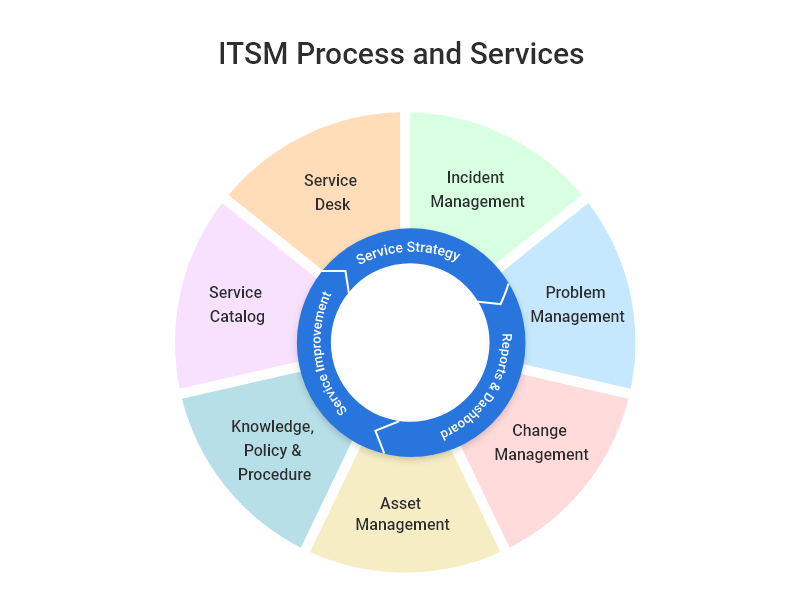If you think ITSM (IT Service Management) is just about technology management, you may want to think again.
Modern ITSM is a strategic approach to designing, delivering, and improving the way IT is used by your internal employees and external customers.
Whether you’re new to this term and wondering “What is ITSM?” or looking to refine your existing processes, this guide is designed to provide you with a thorough understanding of the foundational principles, practices, and benefits of ITSM.
What Is IT Service Management (ITSM)?
IT Service Management (ITSM) refers to the activities involved in designing, creating, delivering, supporting, and managing the lifecycle of IT services in organizations.
Unlike technology management, which focuses on IT infrastructure and hardware, ITSM centers on aligning IT services with business needs and enhancing customer satisfaction. It encompasses a broad range of processes and functions, including incident management, service request management, problem management, change management, and continuous improvement.
ITSM is often guided by frameworks and best practices such as ITIL (Information Technology Infrastructure Library), which provides a structured approach to managing IT services to achieve efficient service delivery and support. Since most people often confuse between the terms ITSM and ITIL, let’s quickly understand the difference between the two in the following section.
What Is the Difference Between ITSM vs. ITIL?
Here’s a comparison of ITSM vs. ITIL, explaining their differences in points:
1. Scope and Focus
ITSM: Broad approach encompassing all activities and processes involved in managing and delivering IT services to meet business needs.
ITIL: A detailed framework of best practices and guidelines specifically aimed at improving IT service management.
2. Purpose
ITSM: Designed to ensure that IT services support business objectives, focusing on customer needs and service delivery.
ITIL: Provides a structured methodology and set of practices for achieving effective IT service management within the broader scope of ITSM.
3. Application
ITSM: Refers to the management of end-to-end IT services, including strategy, design, delivery, operation, and continuous improvement.
ITIL: A tool or framework used within ITSM to help organizations manage IT services more effectively, with a focus on process improvement and service lifecycle management.
4. Flexibility and Customization
ITSM: A generic term that does not prescribe specific processes; organizations can adopt various approaches and frameworks tailored to their unique needs.
ITIL: Offers a specific set of processes and best practices. While it is adaptable, it provides more structured guidance compared to the flexible nature of ITSM.
5. Frameworks and Standards
ITSM: Can be implemented using various frameworks and standards, including ITIL, ISO/IEC 20000, and others, depending on organizational needs.
ITIL: One of the most widely recognized and adopted frameworks for ITSM, but not the only option available to organizations.
By distinguishing ITSM and ITIL in these ways, it becomes clear that ITIL is a subset of ITSM, providing specific practices and guidelines within the broader discipline of IT service management.
What Are the Benefits of ITSM?
Implementing IT Service Management brings numerous benefits to organizations, streamlining IT services and aligning them more closely with business objectives. Here are five key benefits:
1. Improved Service Quality
ITSM frameworks emphasize consistent and repeatable processes, which leads to higher-quality IT services. By adopting best practices for service delivery and support, organizations can reduce downtime, improve system reliability, and ensure services meet user expectations and business requirements.
2. Enhanced Customer Satisfaction
By focusing on the end-user experience and ensuring timely and effective responses to service requests and issues, ITSM helps improve customer satisfaction. Happy customers are more likely to continue using an organization’s services and recommend them to others, contributing to business growth and reputation.
3. Increased Efficiency and Productivity
ITSM encourages the automation of routine tasks and the implementation of standardized processes. This reduces manual workloads, minimizes errors, and allows IT staff to focus on more strategic tasks. As a result, the IT department operates more efficiently, and overall productivity increases.
4. Better Resource Management
With ITSM, organizations gain a clearer understanding of their IT infrastructure and resource utilization. This visibility allows for better planning, allocation, and optimization of resources, ensuring they are used in the most effective way to support business goals.
5. Enhanced Agility and Flexibility
ITSM frameworks support continuous improvement and adaptability by incorporating feedback loops and mechanisms for managing change. This makes organizations more agile and better equipped to respond to changing business environments, technological advancements, and evolving customer needs.
ITSM Frameworks
Several IT Service Management frameworks are widely recognized and adopted by organizations worldwide to streamline their IT services and align them more closely with business goals. Each framework offers a set of best practices, processes, and guidelines designed to improve the efficiency and effectiveness of IT service management. Here are some of the most popular ITSM frameworks:
1. ITIL (Information Technology Infrastructure Library)
ITIL is perhaps the most widely known and utilized ITSM framework globally. It provides a comprehensive set of best practices for delivering high-quality IT services. ITIL focuses on aligning IT services with the needs of businesses and encompasses various aspects of ITSM, including service design, service strategy, service transition, service operation, and continual service improvement.
2. ISO/IEC 20000
This is the first international standard for IT service management. It specifies requirements for an organization to establish, implement, maintain, and continually improve a service management system (SMS). ISO/IEC 20000 helps organizations ensure the effective delivery of services to their customers and is often used in conjunction with ITIL practices.
3. COBIT (Control Objectives for Information and Related Technologies)
COBIT is a framework for the governance and management of enterprise IT that supports business objectives. COBIT provides guidelines and best practices for IT management, focusing on regulatory compliance, risk management, and aligning IT strategy with organizational goals. It is broader than ITIL, covering not just service management but also IT governance.
4. MOF (Microsoft Operations Framework)
MOF includes guidelines for the entire lifecycle of IT services, from creation to management and support. It integrates community-generated processes, governance, risk, and compliance activities, and is designed to help organizations achieve reliability, availability, and manageability of their IT services. MOF is structured around the Plan-Do-Check-Act cycle for continual improvement.
5. Six Sigma
While not exclusively an ITSM framework, Six Sigma is often applied within ITSM contexts to improve the quality of processes by identifying and removing the causes of defects and minimizing variability in manufacturing and business processes. It uses a set of quality management methods, including statistical methods, and creates a special infrastructure of people within the organization.
Each of these frameworks offers unique strengths and focuses, allowing organizations to choose or blend different frameworks according to their specific needs, industry standards, and business objectives.
ITSM Process and Services

Image Source: Easysm.com
IT Service Management comprises various processes designed to ensure the efficient and effective delivery of IT services to meet business needs.
Here are seven popular ITSM processes that are integral to the ITIL framework, one of the most widely adopted ITSM approaches.
1. Incident Management
Incident Management focuses on restoring normal service operations as quickly as possible after an incident while minimizing the impact on business operations.
It involves identifying, analyzing, and correcting hazards to prevent a future re-occurrence of the incident. The primary goal is to minimize downtime and mitigate the adverse effects of incidents.
Read More: 12 Best Incident Management Software for Enhanced IT Support
2. Problem Management
While Incident Management deals with the immediate response to incidents, Problem Management seeks to identify the root causes of incidents and put in place long-term solutions.
The ITSM process of problem management aims to reduce the recurrence of incidents by removing underlying problems from the IT infrastructure, thus improving overall service quality.
3. Knowledge Management
Knowledge Management within ITSM is a process focused on gathering, organizing, sharing, and analyzing knowledge within an organization to improve decision-making, efficiency, and service delivery.
It involves maintaining a centralized repository of knowledge articles, solutions to previous incidents, and procedural documentation to ensure that valuable information is readily accessible. The aim is to enable IT staff and users to quickly find answers to questions and solutions to problems, reducing resolution times and enhancing productivity.
4. Change Management
Change Management is the process of managing all changes to the IT infrastructure, from the initial proposal and justification of the change through to its approval, implementation, and review.
Its aim is to ensure that standardized methods and procedures are used for efficient and prompt handling of all changes, minimizing the impact of change-related incidents upon service quality.
5. Service Request Management
Service Request Management handles requests from users for information, advice, standard changes, or access to services.
It’s often seen as a user-facing process that manages the lifecycle of all service requests, ensuring that requests are fulfilled in an agreed timeframe.
Read More: Incident Vs. Service Request: Understanding the Difference With the Help of Examples
6. Service Level Management (SLM)
Service Level Management (SLM) is the process of negotiating, agreeing, and managing service level agreements (SLAs) with customers.
It ensures that all IT service management processes, operational level agreements, and underpinning contracts are appropriate for the agreed-upon service level targets. SLM monitors and reports on service levels, and holds regular reviews with customers.
Read More: What Is an SLA? Best Practices for Service-Level Agreements
7. Configuration Management
Configuration Management involves maintaining information about configuration items (CIs) required to deliver an IT service, including their relationships.
This process ensures that the assets required to deliver services are accurately recorded and updated, and that the inventory of these assets is kept up to date. It provides valuable information for other ITSM processes, such as Incident and Change Management.
Embracing the Future of ITSM: Key Takeaways & Next Steps
As we wrap up our exploration of IT Service Management (ITSM), it’s clear that ITSM is not just a set of processes but a strategic framework essential for aligning IT services with business objectives.
From improving customer satisfaction to fostering innovation and driving business growth, ITSM plays a pivotal role in the success of modern enterprises. Embracing ITSM is an essential step for any organization looking to navigate the complexities of today’s IT landscape and secure a prosperous future.
If you wish to deliver 24/7 uninterrupted IT support to customers and employees, ProProfs Help Desk can be your ideal solution. You can use this IT ticketing system to create tickets from multiple channels, automate replies with canned responses, and track support performance for continuous improvement.








